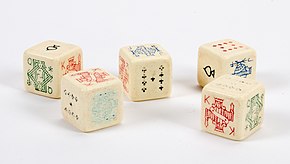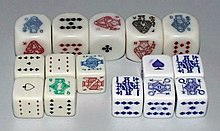|
Poker dice  Poker dice are dice which, instead of having number pips, have representations of playing cards upon them. Poker dice have six sides, one each of an Ace, King, Queen, Jack, 10, and 9, and are used to form a poker hand. EquipmentEach variety of poker dice varies slightly in regard to suits, though the ace of spades is almost universally represented. 9♣ and 10♦ are frequently found, while face cards are traditionally represented not by suit, but instead by color: red for kings, green for queens and blue for jacks. Manufacturers have not standardized the colors of the face sides. Note that neither a "flush" nor a "straight flush" is possible, due to the lack of suits on the dice.[1][2] The game also may be played with ordinary dice. In this case, the 1-pip side is high, representing the ace, followed by 6 (K), 5 (Q), 4 (J), 3 (10), and 2 (9).[3][4] On mutual agreement, players may designate certain faces as wild.[5] As a game The classic poker dice game is played with five six-sided dice and two or more players, but typically no more than five.[5] Each player has a total of three rolls and the ability to hold dice in between rolls.[5] After the three rolls, the best hand wins. In some variations, only two rolls are allowed,[3] and in others, the number of dice that may be re-rolled is limited to three.[4] If the first to roll uses less than three rolls, generally that limit applies to subsequent players.[5][6]: 242 Ties are broken by the dice used in the combination, then by the dice not counted in the combination. For example, suppose three players each have four of a kind. They would rank as follows:
Alternatively, and especially when the five dice are shared amongst the players, the dice not used in the combination can be disregarded, speeding up the game, although there could be more ties.[6]: 240, 241 Straights, flushes, and bustsBecause there are six faces on each die and five dice, there are six distinct rolls in which all five dice have different values:
Each of these sequences has an exact probability of 120⁄7776. In older variations of the game, straights are counted as busts.[5] There are only two possible straights with Poker Dice, namely:[6]
The combined probability of rolling either straight is 240⁄7776. This means a Straight is less probable than a Full House (300⁄7776), so, if counted, it should rank above a Full House, though tradition usually ranks it below Full House, as in card poker. In some rules, only the low straight to a King [9 10 J Q K] is called a Straight, while the high straight to an Ace [10 J Q K A] is called (incorrectly) a Flush. Under these rules, the Straight (low straight) beats a Full House (unlike in card poker, but correctly reflecting its probability) but does not beat a Four of a Kind (incorrectly reflecting its lower probability). A Flush (high straight) beats a Four of a Kind (unlike in card poker, but correctly reflecting its lower probability). Alternatively, a straight could be ranked between four and five of a kind, or either of the four bust hands could be called a flush, ranking between a full house and a straight.[6]: 241 ProbabilitiesThere are 65 = 7,776 potential combinations when rolling five six-sided dice. The poker dice hand rankings and the corresponding probabilities of rolling that hand are as follows:[7][8][9][10]
The combined probability of a straight or a bust is 720⁄7776. As previously noted, variations of the game may rank the straight higher than a full house, and a bust higher than three of a kind. VariantsMarlboro once marketed a set of octahedral poker dice that included suits; each die had slightly different numberings, ranging from 7 up to ace. A similar set is currently manufactured by Koplow Games.[13][14] In 1974, Aurora produced a set of 12-sided poker dice called "Jimmy the Greek Odds Maker Poker Dice"[15] and in 2000, Aurora/Rex Games produced a similar set under the name "Royal Poker Dice".[16] The sets featured five 12-sided dice allowing for all 52 playing cards to be represented. The remaining 8 faces featured stars and acted as wild cards allowing for every possible poker hand to be rolled. A two-player variant of the game Liar's Dice can be played with Poker dice. Players roll their own set of Poker dice behind a screen, and bid and call based on Poker dice hands. See alsoReferences
External linksWikimedia Commons has media related to Poker dice.
|
|||||||||||||||||||||||||||||||||||||||||||||||||||||||||||||||||||||||||||||
